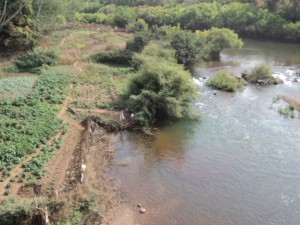Food crisis in Senegal: Lack of rain triggers bad harvests

First of two posts by Oxfam’s regional communication officer in Senegal, Aliou Bassoum.
This year there is another food crisis knocking at the door of the Sahel, and it is threatening about 850,000 people in Senegal. Many of them live in Kolda, southern Senegal, and in Kedougou in the east, about 12 hours from Dakar by car.
I’ve just visited these areas over the last few weeks with the humanitarian team planning our response, and in each of the villages we heard a similar story: The last harvest was not good, and people are hungry. Many agricultural communities experience a hungry period while their crops are in the ground and they finish eating the food harvested from the previous year. But this year the lean season is happening four or five months earlier than normal.
Some of the families we met already had empty granaries in February. “I harvested nothing last year, because of floods and then poor rains,” says, Amadou Noba, holding his chin as he speaks to us in the shade of a big tree near the primary school in the village of Sémécouta, in the Kedougou region. Noba is 60, and is married with two wives and 12 children. “Normally I would grow about 100kg (220 pounds) of corn,” he says.
Sémécouta is a village a 1,200 people, mostly farmers, with just one shop and some small houses along the main road to the border with Mali. Everywhere we look, the land is dry, except in some areas very close to the river Gambia.
Noba and many others are looking for alternative means to feed their children. Some are eating leaves from trees, or wild fruits like pain de singe (“monkey bread”) from the seed pod of the baobab tree, which one elderly woman showed us as she went to serve it to her family.
Growing winter vegetables, usually an activity for women, has become an important source of income. Vegetable sales help many families buy staple foods at local markets. But this means of coping is running into other major problems: lack of water in nearby wells (essential for growing vegetables in the dry season), and the poor state of roads that make it hard to transport vegetables to markets in urban areas. Even when women can sell some produce, shortages in local markets make it hard to find staple foods like rice they want to buy.
Water worries
Poor and erratic rainfall ruined last year’s production of rice, corn, and peanuts. But many farmers in the Kedougou region also suffered from flooding. The river Gambia, which flows from Guinea, where there was abundant rain last year, spilled over its banks into nearby corn fields, washing away the crop. But farmers like Noba still prefer to plant their corn on the banks of the river as the seasonal floods recede because “you can get two harvests of corn per year.”

This year farmers are worried because the poor harvest in 2011 makes it hard for them to set aside enough seed to plant corn, rice, and peanuts, and they can’t always get seeds and fertilizer at the right time from other sources. “To have enough seed, you need a good harvest,” says Kémoko Touré, the imam in Sémécouta. “The last good harvest was in 2008, when we had four or five months of food,” he says, raising his finger to the sky.
Leaving Kedougou, I was asking myself why a crisis like this can hit this part of Senegal, where there is a river with a lot water, and fertile land. One 80-year-old man, Bintou Bangaly, explained the problem: “We can’t expect good results from using just a hoe,” he says. Farmers just can’t continue to rely on rain-fed agriculture anymore. They need irrigation and modern farming systems if they expect to produce enough food for people living in the Sahel.
Oxfam is developing a nine- month project to support people at risk in Kedougou and other drought-stricken areas of Senegal. We’ll provide farming support for the most vulnerable farmers, so they can feed their families during the lean season and plant crops in the spring.
Oxfam is aiming to help 1.2 million people across seven countries with programs that include cash transfers and cash-for-work initiatives, veterinary care for the livestock on which many families depend, and access to clean water and sanitation. We are also campaigning to change the root causes of this crisis. Find out how you can support our efforts.
